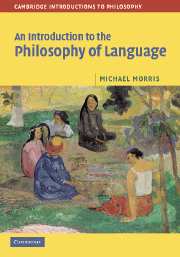Book contents
- Frontmatter
- Contents
- Acknowledgements
- Introduction
- 1 Locke and the nature of language
- 2 Frege on Sense and reference
- 3 Russell on definite descriptions
- 4 Kripke on proper names
- 5 Natural-kind terms
- 6 Quine on de re and de dicto modality
- 7 Reference and propositional attitudes
- 8 The semantics of propositional attitudes
- 9 Davidson on truth and meaning
- 10 Quine and Davidson on translation and interpretation
- 11 Quine on the indeterminacy of translation
- 12 Austin on speech acts
- 13 Grice on meaning
- 14 Kripke on the rule-following paradox
- 15 Wittgenstein on the Augustinian picture
- Glossary
- Works cited
- Index
15 - Wittgenstein on the Augustinian picture
Published online by Cambridge University Press: 05 June 2012
- Frontmatter
- Contents
- Acknowledgements
- Introduction
- 1 Locke and the nature of language
- 2 Frege on Sense and reference
- 3 Russell on definite descriptions
- 4 Kripke on proper names
- 5 Natural-kind terms
- 6 Quine on de re and de dicto modality
- 7 Reference and propositional attitudes
- 8 The semantics of propositional attitudes
- 9 Davidson on truth and meaning
- 10 Quine and Davidson on translation and interpretation
- 11 Quine on the indeterminacy of translation
- 12 Austin on speech acts
- 13 Grice on meaning
- 14 Kripke on the rule-following paradox
- 15 Wittgenstein on the Augustinian picture
- Glossary
- Works cited
- Index
Summary
Key text
Ludwig Wittgenstein, Philosophical Investigations, trans. G. E. M. Anscombe, 3rd edn (Oxford: Blackwell, 2001), part I, §§ 1–32.
Introduction
This last chapter is devoted to a small extract from a work by one of the most puzzling and awkward figures in the analytic tradition of philosophy of language. Ludwig Wittgenstein met and corresponded with Frege, and was taught by Russell. His first work, the Tractatus Logico-Philosophicus, adapted and refined many of their ideas on logic and language. It inspired the scientifically minded philosophers who made up the Vienna Circle, and who in turn had a profound influence on analytic philosophy, particularly in America.
Wittgenstein's later work, of which the Philosophical Investigations is the principal text, divides the English-speaking philosophical community. He is often dismissed by those who have a broadly scientific approach to philosophy, though he's read keenly by many of those who don't. This is partly to do with the style of his writing (though, of course, the style embodies something of his philosophy). The Philosophical Investigations is not organized systematically: it has no chapters and no simple sequence of thought; it is even disputed whether it contains arguments. Much of it has the form of a probing conversation of the author with himself: Wittgenstein raises a worry – often on behalf of a more traditional approach to philosophy – responds to it, responds to the response, and so on.
- Type
- Chapter
- Information
- An Introduction to the Philosophy of Language , pp. 292 - 311Publisher: Cambridge University PressPrint publication year: 2006



